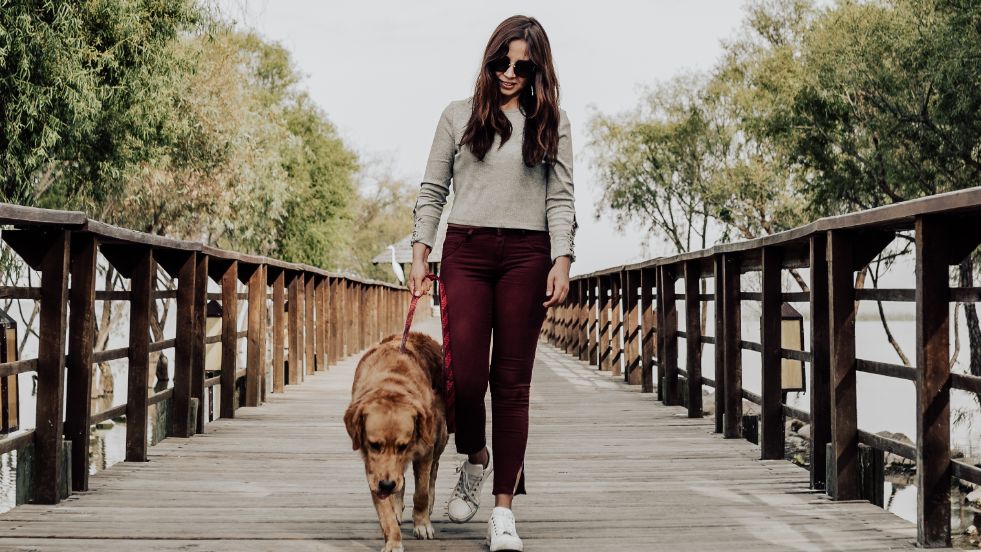Dog walking isn’t just about stretching legs or bathroom breaks—it’s the cornerstone of your dog’s physical and emotional health. Regular walks improve cardiovascular fitness, reduce behavioral issues, and deepen the bond between pet and owner. A 2019 study in Preventive Veterinary Medicine found that dogs who are walked daily show lower stress levels, fewer destructive habits, and healthier body weights (1).
Yet, many owners underestimate the details that go into a safe and enriching walk. Here are 15 tips that every dog owner should know to turn daily walks into enjoyable, rewarding routines.
15 Dog Walking Tips Every Owner Should Know
1. Choose the Right Leash and Harness
Skip retractable leashes—they encourage pulling and reduce control. Instead, opt for a sturdy 4–6-foot leash paired with a well-fitted harness, especially for strong pullers. Harnesses distribute pressure evenly and protect your dog’s neck.
2. Pick the Best Time of Day
Morning or evening walks are ideal, especially in hot climates. Midday heat can overheat your dog and burn their paws on asphalt. A quick “palm test”—if it’s too hot for your hand, it’s too hot for paws—can prevent injury.
3. Always Carry the Essentials
Think of dog walking like a mini adventure. Essentials include poop bags, a portable water bottle, and a few treats for training or rewarding calm behavior. Being prepared makes the walk smoother for both of you.
4. Start Slow With Puppies and Seniors
Young puppies and older dogs have different exercise needs. Puppies shouldn’t over-exercise, as their joints are still developing, while seniors may require shorter, gentler walks. Adjust duration based on your dog’s age and fitness level.
5. Stay Visible and Safe at Night
If you walk during low-light hours, use reflective gear or LED collars for your dog, and wear light-colored clothing yourself. Visibility keeps you both safe from traffic and cyclists.
6. Avoid Extreme Weather Hazards
Hot pavements in summer and icy sidewalks in winter can be painful or dangerous. Booties can help, but choosing safer times and routes is the best protection. Remember—dogs regulate heat less effectively than humans.
7. Be Mindful of Surroundings
Keep your eyes peeled for broken glass, toxic plants, or food scraps. Dogs explore with their mouths, and a split-second sniff could turn into swallowing something harmful.
8. Respect Leash Laws and Personal Space
Not every dog is friendly. Always ask before allowing your dog to greet another, and don’t assume strangers want to interact. Respecting space reduces the chance of altercations.
9. Train Good Leash Manners
A dog constantly pulling isn’t fun for anyone. Teaching loose-leash walking using positive reinforcement—rewarding calm walking beside you—makes walks more enjoyable and less stressful.
10. Change Up the Route
Just like humans, dogs get bored with routine. Switching up walking paths introduces new smells and sights, stimulating their brains and preventing monotony.
11. Allow Time for Sniff Breaks
A walk isn’t just about cardio—it’s your dog’s chance to explore the world through scent. Research in Applied Animal Behaviour Science suggests sniffing lowers canine stress levels. Allow your dog to pause and “read the newspaper” of the neighborhood (2).
12. Play Training Games During Walks
Turn walks into mini training sessions—practice “sit,” “heel,” or “stay” in different environments. This builds focus and reinforces good behavior, even in distracting situations.
13. Incorporate Socialization Safely
If your dog enjoys company, walks are a great opportunity for socialization. Meeting calm, friendly dogs under supervision builds confidence and reduces reactivity. Just ensure interactions are positive and brief.
14. Keep Walks Engaging With Variety
Add fun elements like short jogs, small obstacles (like curbs to hop over), or “find it” games with hidden treats. Mental and physical stimulation combined create a more satisfying experience.
15. End on a Positive Note
Finish every walk with praise, a cuddle, or a small reward. Dogs remember the last moments vividly, so a positive ending builds excitement for the next outing.
The Science Behind Dog Walking Benefits
Dog walking is more than routine—it’s science-backed well-being. Studies highlight that:
- Physical health: Daily walks reduce obesity risk and improve cardiovascular function.
- Behavioral health: Dogs with regular exercise show fewer destructive behaviors like chewing or barking.
- Bonding: Walking together strengthens trust and communication between owner and pet.
- Owner benefits: A study in BMC Public Health found that dog owners who walk regularly are more likely to meet daily exercise goals themselves (3).
In other words, walking benefits both ends of the leash.
FAQs Frequently Asked Quetions
1. How long should I walk my dog each day?
A. Most dogs need 30–60 minutes of walking, but active breeds like Border Collies or Huskies may require much more. Always adapt to your dog’s needs.
2. Should I feed my dog before or after a walk?
A. It’s safer to wait 1–2 hours after meals before strenuous activity, especially for large breeds prone to bloat.
3. Is off-leash walking safe?
A. Only in secure, legal areas where your dog has excellent recall training. Safety and control should always come first.
Conclusion:
Walking your dog is a daily responsibility that pays back in loyalty, health, and happiness. By focusing on safety, stimulation, and training, you can transform a basic walk into the highlight of your dog’s day—and yours too.
Remember: every step together strengthens your bond. So grab that leash, keep these tips in mind, and enjoy the journey one paw at a time.
References:
1. The Benefits of Walking Your Dog
2. Raising A Puppy
3. A cross-sectional study of factors associated with regular dog walking











